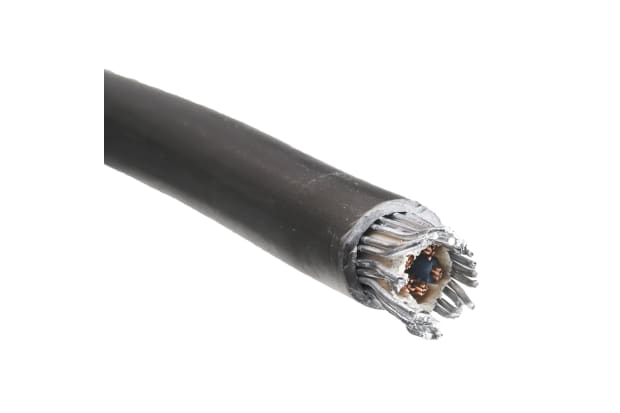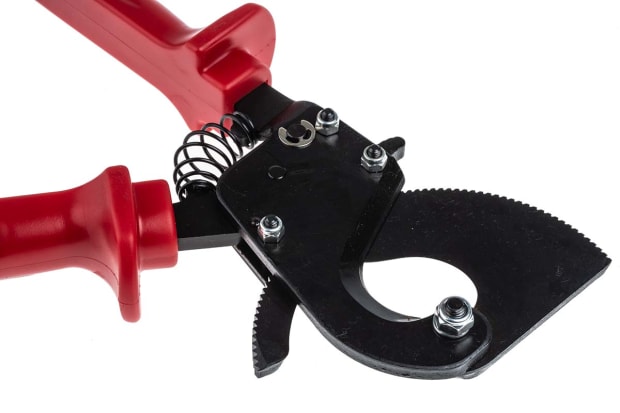- Published 17 Jan 2023
- Last Modified 29 Aug 2023
- 6 min
Armoured Cable FAQs
Discover the answers to all your armoured cable and SWA cable FAQs in this handy guide.

What is SWA Cable?
Steel wire armoured (SWA) cable is a type of hard-wearing, reinforced power and auxiliary control cable. These cables are often found in electrical installations in harsh environments, serving as final and distribution circuits.
SWA cables provide a continuous flow of current. This is because they contain galvanised steel which overlaps the central cable. Each cable consists of multiple copper cores - the exact number varies between cables - surrounded by XLPE insulation. A layer of PVC bedding secured by steel wire is then put in place to protect the outer insulation and core cable. The cable is completed with a durable PVC coating that covers the entirety of the cable and forms the outer layer.
When to Use Armoured Cable?

Due to their durability, armoured power cables are ideal for use in harsh and potentially hazardous environments. They are designed to supply an uninterrupted electrical connection, offering increased protection, and therefore decreasing the risk of power loss. As a result, these cables are best suited to applications where there is high traffic, risk of interference from debris, or rough surfaces and install locations.
So, what is armoured cable used for? Steel wire armoured cable uses and applications include:
- Underground cabling systems
- Manufacturing and factories
- Construction and building sites
- Transport such as along train tracks
- Power stations
- Outdoor or high-risk workshops
- Cable ducting
What Armoured Cable Types are Available?
Armoured cable is typically a single standard cable with little variation. Instead, the most frequent variations relate to specific cable sizes such as the number of cores, cable length, and overall diameter.
Each is a galvanised steel wire armour cable, though the outer sheathing can vary between different types. The most common options include PVC sheaths and LSZH (Low Smoke Zero Halogen) sheaths.
Which Standards are Applicable to SWA Cable?
High-quality, reliable SWA cables are essential to protect and sustain mains electrical connections in harsh environments and applications.
When buying SWA cables in the UK, you should look for products that are BASEC approved to BS5467 standard. The British Approvals Service for Cables (BASEC) provides certification for products that have been comprehensively tested and meet its strict compliance standards. BS5467 is applicable for EPR or XLPE insulated and PVC-sheathed low voltage SWA cables. It means the cable meets the British standards for testing and construction.
Standards may vary internationally so always make sure to double-check the correct standards and armoured cable specifications for your requirements.
How to Select an Armoured Cable Gland?
Steel wire armoured cable is available with a wide range of different diameters and core sizes for various applications. Each size requires matching up with the corresponding SWA cable gland sizes for installation. Choosing the right armoured cable connector is important for ensuring a secure fit and a reliable connection.
This SWA cable gland size chart should help you to select the right gland for your requirements:
Cable Size (mm²) | 1 Core | 2 Core | 3 Core | 4 Core | 5 Core | 7 Core | 12 Core | 19 Core | 27 Core | 37 Core | 48 Core |
|---|---|---|---|---|---|---|---|---|---|---|---|
| 1.5 | 20S | 20S | 20S | 20S | 20 | 25 | 25 | 32 | 32 | 32 | |
| 2.5 | 20S | 20S | 20S | 20 | 20 | 25 | 25 | 32 | 40 | 40 | |
| 4 | 20S | 20S | 20 | 20 | 20 | 25 | 32 | 40 | 40 | 50 | |
| 6 | 20 | 20 | 20 | 20 | 25 | ||||||
| 10 | 20 | 20 | 25 | 25 | |||||||
| 16 | 25 | 25 | 25 | 25 | |||||||
| 25 | 25 | 25 | 32 | 32 | |||||||
| 35 | 32 | 32 | 32 | 40 | |||||||
| 50 | 20 | 32 | 32 | 40 | 50 | ||||||
| 70 | 20 | 32 | 32 | 40 | 50 | ||||||
| 95 | 25 | 32 | 40 | 50S | |||||||
| 120 | 25 | 40 | 50S | 50 | |||||||
| 150 | 32 | 40 | 50S | 50 | |||||||
| 185 | 32 | 50S | 50 | 63S | |||||||
| 240 | 32 | 50 | 63S | 63 | |||||||
| 300 | 40 | 63S | 63 | 75S | |||||||
| 400 | 40 | 63S | 75S | 75 |
How to Fit Armoured Cable Glands?
You should keep in mind that armoured power cables must be suitably supported to prevent placing unnecessary strain on the gland termination. Ensuring the proper support is in place will also help to prevent the likelihood of incurring damage to cables caused by their weight.
This is especially important when working with cables that are connected to enclosures. These types of connections must provide both mechanical strength and electrical continuity, so using the correct gland to terminate the armouring is essential. In the case of metallic enclosures, it's recommended to bolt the brass earth tag to the enclosure to maintain electrical continuity.
Always make sure to follow the manufacturer's guidelines when fitting SWA glands and terminating armoured cable.

Find out more in our comprehensive cable glands guide, covering everything you need to know to select the best gland for the task at hand.
How to Lay Armoured Cable Correctly?
When laying armoured cable underground, the cable must be laid at a sufficient depth to avoid the potential for damage or disturbance. If this is not possible, consider increasing the depth of direct burial underground, or providing additional protection for improved security.
Although BS7671 standards do not state a single minimum depth, it's important to ensure that electrical cable will not be disturbed by typical activity. A minimum installation depth of 450mm underground is typically recommended for best practice. This increases to 600mm in locations where there is a higher possibility for potential disturbance.
If installed directly into the ground, the cable should be surrounded by sharp sand to protect against damage to the sheath or insulation. Electrical warning tape should also be in place above the sand to indicate that the cable is present below. On the flip side, if the cable is being installed within a pipe, you must ensure it is watertight to prevent ingress.
It is also important to note that SWA must always be earthed, regardless of whether the armouring is being used as a protective conductor or not. This ensures that automation disconnection of supply (ADS) requirements are fulfilled. The importance of this should not be overlooked, as the development of a fault on a cable that is not effectively earthed could potentially pose a dangerous risk to individuals.
Full, rigorous testing should always be completed post-installation by a qualified electrician. This will ensure that it is both safe and compliant.
How to Cut Armoured Cable?

There are several different tools you can use to cut armoured cable. The best option is to use dedicated cable cutters which are designed with this task in mind. Side cutters or a hacksaw can also be used as alternatives, but cable cutters are recommended where possible.
Follow these steps to use cable cutters safely and efficiently:
- Accurately measure the cable length required and mark the outer sheath at the cutting point
- Adjust the cutters' blade depth to ensure the correct depth for cutting through the armour
- Position the cable in the cutters' wire guide, align with the marked cutting point and secure it in place
- Carefully make the cut
- Remove the newly cut cable from the cutters
What Size Armoured Cable Do I Need?
Armoured cable is available in a wide range of sizes for different applications. The size cable you need will depend on various factors, including:
- Install environment
- Length required
- Current rating (Amps)
- Typical conditions
- Domestic or industrial location
The size can also refer to several different measurements, mainly:
- Length (m)
- Diameter (mm)
- Gland size
- Overall dimensions
Understanding what size armoured cable is best for your application is crucial as it will determine many of the key considerations you should be considering.
Is Armoured Cable Suitable for Wet & Waterlogged Environments?
An IP rated cable and gland are essential for installation outdoors. The same is also true for environments that are wet, waterlogged or have the potential for dirt or dust ingress. The connection should offer the appropriate IP rating and the cable should be installed to minimise the potential effects of harmful external influences where possible.
How Much Can I Bend SWA Cable?
Depending on the specific application and environment, SWA armoured cable may be required to bend and fit along contours, corners, or holes during the installation process. However, its weight and rigidity mean that care must be taken if it needs to be bent. Therefore, armoured cable is often used underground or fixed in long, straight runs using cable cleats.
Armoured cable has a specified bending radius based on the overall diameter. You must not bend a cable to a smaller radius than the minimum value advised. The minimum bend radius will typically be either six or eight times the diameter, depending on the specific type. Always make sure to check the manufacturer's instructions before installation to determine the minimum internal radius of bend for your cable.

